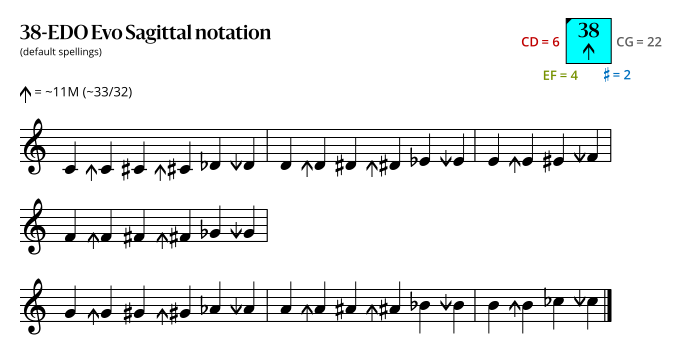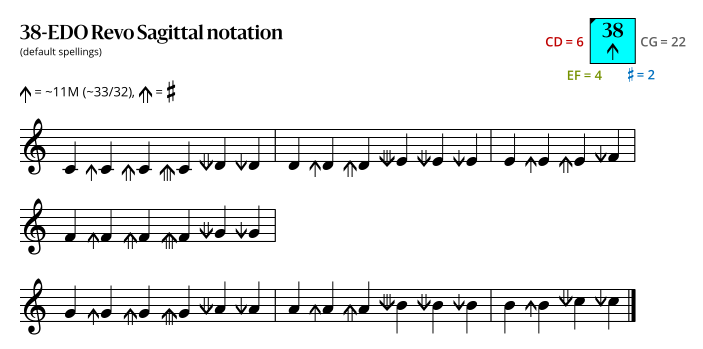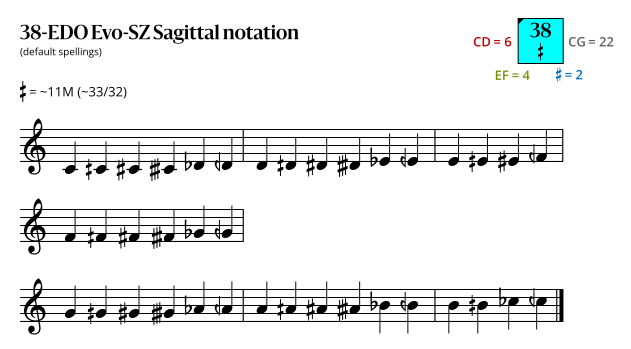38edo: Difference between revisions
Contribution (talk | contribs) No edit summary |
→Approximation to JI: -zeta peak index |
||
| (14 intermediate revisions by 5 users not shown) | |||
| Line 1: | Line 1: | ||
{{Infobox ET}} | {{Infobox ET}} | ||
{{ | {{ED intro}} | ||
== Theory == | == Theory == | ||
Since {{nowrap|38 {{=}} 2 × 19}}, it can be thought of as two parallel [[19edo]]s. While the halving of the step size lowers [[consistency]] and leaves it only mediocre in terms of overall [[relative interval error|relative error]], the fact that the 3rd | Since {{nowrap|38 {{=}} 2 × 19}}, it can be thought of as two parallel [[19edo]]s. While the halving of the step size lowers [[consistency]] and leaves it only mediocre in terms of overall [[relative interval error|relative error]], the fact that the 3rd and 5th harmonics are flat by almost exactly the same amount, while the 11th is double that means there are quite a few near perfect composite ratios, such as the the [[6/5]] it shares with 19edo, plus [[11/9]], [[15/11]] & [[25/22]], (and their inversions) while a single step nears [[55/54]]; the approximation to [[11/9]] in particular should be noted for forming a 10-strong [[consistent circle]]. This gives several interesting possibilities for unusual near-just chords such as 15:18:22:25:30. | ||
In [[Warts|38df]], every [[prime interval]] from 3 to 19 is characterized by a flat intonation. Furthermore, the [[mapping]] of all [[19-odd-limit]] intervals in 38df aligns with their closest approximations in 38edo, excepting for 7/4 and 13/8, along with their octave complements 8/7 and 16/13, which are by definition mapped to their secondary optimal steps within 38df. In other words, all 19-odd-limit intervals are [[consistency|consistent]] within the 38df [[val]] {{val| 38 60 88 106 131 140 155 161 }}. | It [[tempering out|tempers out]] the same [[5-limit]] commas as 19edo, namely [[81/80]], [[3125/3072]] and [[15625/15552]]. In the [[7-limit]], we can add [[50/49]], and tempering out 81/80 and 50/49 gives [[injera]] temperament, for which 38 is the [[optimal patent val]]. In the [[11-limit]], we can add 121/120 and 176/175. | ||
Using the [[Warts|38df]] mapping, every [[prime interval]] from 3 to 19 is characterized by a flat intonation. Furthermore, the [[mapping]] of all [[19-odd-limit]] intervals in 38df aligns with their closest approximations in 38edo, excepting for 7/4 and 13/8, along with their octave complements 8/7 and 16/13, which are by definition mapped to their secondary optimal steps within 38df. In other words, all 19-odd-limit intervals are [[consistency|consistent]] within the 38df [[val]] {{val| 38 60 88 106 131 140 155 161 }}. | |||
The harmonic series from 1 to 20 is approximated within 38df by the sequence: {{nowrap| 38 22 16 12 10 8 8 6 6 5 5 4 4 4 4 3 3 3 3 }} | The harmonic series from 1 to 20 is approximated within 38df by the sequence: {{nowrap| 38 22 16 12 10 8 8 6 6 5 5 4 4 4 4 3 3 3 3 }} | ||
| Line 21: | Line 23: | ||
! 19-odd-limit ratios,<br>in 38df val | ! 19-odd-limit ratios,<br>in 38df val | ||
! colspan="3" | [[Ups and downs notation]]* | ! colspan="3" | [[Ups and downs notation]]* | ||
([[Enharmonic unisons in ups and downs notation|EUs]]: vvA1 and vvd2) | |||
|- | |- | ||
| 0 | | 0 | ||
| Line 297: | Line 300: | ||
<nowiki/>* Ups and downs may be substituted with semi-sharps and semi-flats, respectively | <nowiki/>* Ups and downs may be substituted with semi-sharps and semi-flats, respectively | ||
== Notation == | == Notation == | ||
===Sagittal notation=== | === Ups and downs notation === | ||
Spoken as up, sharp, upsharp, etc. Note that up can be respelled as downsharp. | |||
{{sharpness-sharp2a}} | |||
=== Quarter-tone notation === | |||
Since a sharp raises by two steps, [[24edo#Notation|quarter-tone accidentals]] can also be used: | |||
{{sharpness-sharp2}} | |||
=== Sagittal notation === | |||
This notation uses the same sagittal sequence as EDOs [[17edo#Sagittal notation|17]], [[24edo#Sagittal notation|24]], and [[31edo#Sagittal notation|31]], is a subset of the notation for [[76edo#Sagittal notation|76-EDO]], and is a superset of the notation for [[19edo#Sagittal notation|19-EDO]]. | This notation uses the same sagittal sequence as EDOs [[17edo#Sagittal notation|17]], [[24edo#Sagittal notation|24]], and [[31edo#Sagittal notation|31]], is a subset of the notation for [[76edo#Sagittal notation|76-EDO]], and is a superset of the notation for [[19edo#Sagittal notation|19-EDO]]. | ||
==== Evo flavor ==== | |||
<imagemap> | <imagemap> | ||
File:38-EDO_Evo_Sagittal.svg | File:38-EDO_Evo_Sagittal.svg | ||
| Line 341: | Line 322: | ||
</imagemap> | </imagemap> | ||
====Revo flavor==== | ==== Revo flavor ==== | ||
<imagemap> | <imagemap> | ||
File:38-EDO_Revo_Sagittal.svg | File:38-EDO_Revo_Sagittal.svg | ||
| Line 352: | Line 332: | ||
</imagemap> | </imagemap> | ||
====Evo-SZ flavor==== | ==== Evo-SZ flavor ==== | ||
<imagemap> | <imagemap> | ||
File:38-EDO_Evo-SZ_Sagittal.svg | File:38-EDO_Evo-SZ_Sagittal.svg | ||
| Line 364: | Line 343: | ||
Because it contains no Sagittal symbols, this Evo-SZ Sagittal notation is also a Stein-Zimmerman notation. | Because it contains no Sagittal symbols, this Evo-SZ Sagittal notation is also a Stein-Zimmerman notation. | ||
== Approximation to JI == | |||
=== Interval mappings === | |||
{{Q-odd-limit intervals}} | |||
== Instruments == | == Instruments == | ||
| Line 370: | Line 353: | ||
== Music == | == Music == | ||
* [https://www.youtube.com/watch?v=Cw1Cz1ojoSw Canon at the Semitone on The Mother's Malison Theme for Cor Anglais and Violin] | ; [[Bryan Deister]] | ||
* [https://www.youtube.com/shorts/rewy-32BfRs ''Spirit of the Night - Secret of Mana (microtonal cover in 38edo)''] (2025) | |||
; [[Claudi Meneghin]] | |||
* [https://www.youtube.com/watch?v=Cw1Cz1ojoSw Canon at the Semitone on The Mother's Malison Theme for Cor Anglais and Violin] (2022) | |||
[[Category:38edo| ]] <!-- Main article --> | [[Category:38edo| ]] <!-- Main article --> | ||
Latest revision as of 00:05, 16 August 2025
| ← 37edo | 38edo | 39edo → |
38 equal divisions of the octave (abbreviated 38edo or 38ed2), also called 38-tone equal temperament (38tet) or 38 equal temperament (38et) when viewed under a regular temperament perspective, is the tuning system that divides the octave into 38 equal parts of about 31.6 ¢ each. Each step represents a frequency ratio of 21/38, or the 38th root of 2.
Theory
Since 38 = 2 × 19, it can be thought of as two parallel 19edos. While the halving of the step size lowers consistency and leaves it only mediocre in terms of overall relative error, the fact that the 3rd and 5th harmonics are flat by almost exactly the same amount, while the 11th is double that means there are quite a few near perfect composite ratios, such as the the 6/5 it shares with 19edo, plus 11/9, 15/11 & 25/22, (and their inversions) while a single step nears 55/54; the approximation to 11/9 in particular should be noted for forming a 10-strong consistent circle. This gives several interesting possibilities for unusual near-just chords such as 15:18:22:25:30.
It tempers out the same 5-limit commas as 19edo, namely 81/80, 3125/3072 and 15625/15552. In the 7-limit, we can add 50/49, and tempering out 81/80 and 50/49 gives injera temperament, for which 38 is the optimal patent val. In the 11-limit, we can add 121/120 and 176/175.
Using the 38df mapping, every prime interval from 3 to 19 is characterized by a flat intonation. Furthermore, the mapping of all 19-odd-limit intervals in 38df aligns with their closest approximations in 38edo, excepting for 7/4 and 13/8, along with their octave complements 8/7 and 16/13, which are by definition mapped to their secondary optimal steps within 38df. In other words, all 19-odd-limit intervals are consistent within the 38df val ⟨38 60 88 106 131 140 155 161].
The harmonic series from 1 to 20 is approximated within 38df by the sequence: 38 22 16 12 10 8 8 6 6 5 5 4 4 4 4 3 3 3 3
[Harmonic series 2-20 in 38df]
Prime harmonics
| Harmonic | 2 | 3 | 5 | 7 | 11 | 13 | 17 | 19 | 23 | 29 | 31 | |
|---|---|---|---|---|---|---|---|---|---|---|---|---|
| Error | Absolute (¢) | +0.0 | -7.2 | -7.4 | +10.1 | -14.5 | +12.1 | -10.2 | -13.3 | +3.3 | +12.5 | -8.2 |
| Relative (%) | +0.0 | -22.9 | -23.3 | +32.1 | -45.8 | +38.3 | -32.4 | -42.1 | +10.5 | +39.7 | -25.9 | |
| Steps (reduced) |
38 (0) |
60 (22) |
88 (12) |
107 (31) |
131 (17) |
141 (27) |
155 (3) |
161 (9) |
172 (20) |
185 (33) |
188 (36) | |
Intervals
| Step | Cents | 19-odd-limit ratios, in 38df val |
Ups and downs notation*
(EUs: vvA1 and vvd2) | ||
|---|---|---|---|---|---|
| 0 | 0.0 | Perfect 1sn | P1 | D | |
| 1 | 31.6 | Up 1sn | ^1 | ^D | |
| 2 | 63.2 | Aug 1sn, dim 2nd | A1, d2 | D# | |
| 3 | 94.7 | 20/19, 19/18, 18/17, 17/16 | Upaug 1sn, downminor 2nd | ^A1, vm2 | ^D#, vEb |
| 4 | 126.3 | 16/15, 15/14, 14/13, 13/12 | Minor 2nd | m2 | Eb |
| 5 | 157.9 | 12/11, 11/10 | Mid 2nd | ~2 | vE |
| 6 | 189.5 | 10/9, 19/17, 9/8 | Major 2nd | M2 | E |
| 7 | 221.1 | 17/15 | Upmajor 2nd | ^M2 | ^E |
| 8 | 252.6 | 8/7, 15/13, 22/19, 7/6 | Aug 2nd, Dim 3rd | A2, d3 | E#, Fb |
| 9 | 284.2 | 20/17, 13/11, 19/16 | Downminor 3rd | vm3 | vF |
| 10 | 315.8 | 6/5 | Minor 3rd | m3 | F |
| 11 | 347.4 | 17/14, 11/9 | Mid 3rd | ~3 | ^F |
| 12 | 378.9 | 16/13, 5/4 | Major 3rd | M3 | F# |
| 13 | 410.5 | 24/19, 19/15, 14/11 | Upmajor 3rd, Downdim 4th | ^M3, vd4 | ^F#, vGb |
| 14 | 442.1 | 9/7, 22/17, 13/10 | Aug 3rd, dim 4th | A3, d4 | Gb |
| 15 | 473.7 | 17/13 | Down 4th | v4 | vG |
| 16 | 505.3 | 4/3 | Perfect 4th | P4 | G |
| 17 | 536.8 | 19/14, 15/11, 26/19, 11/8 | Up 4th | ^4 | ^G |
| 18 | 568.4 | 18/13, 7/5 | Aug 4th | A4 | G# |
| 19 | 600.0 | 24/17, 17/12 | Upaug 4th, downdim 5th | ^A4, vd5 | ^G#, vAb |
| 20 | 631.6 | 10/7, 13/9 | Dim 5th | d5 | Ab |
| 21 | 663.2 | 16/11, 19/13, 22/15, 28/19 | Down 5th | v5 | vA |
| 22 | 694.7 | 3/2 | Perfect 5th | P5 | A |
| 23 | 726.3 | 26/17 | Up 5th | ^5 | ^A |
| 24 | 757.9 | 20/13, 17/11, 14/9 | Aug 5th, dim 6th | A5, d6 | A# |
| 25 | 789.5 | 11/7, 30/19, 19/12 | Upaug 5th, downminor 6th | ^A5, vm6 | ^A#, vBb |
| 26 | 821.1 | 8/5, 13/8 | Minor 6th | m6 | Bb |
| 27 | 852.6 | 18/11, 28/17 | Mid 6th | ~6 | vB |
| 28 | 884.2 | 5/3 | Major 6th | M6 | B |
| 29 | 915.8 | 32/19, 22/13, 17/10 | Upmajor 6th | ^M6 | ^B |
| 30 | 947.4 | 12/7, 19/11, 26/15, 7/4 | Aug 6th, dim 7th | A6, d7 | B#, Cb |
| 31 | 978.9 | 30/17 | Downminor 7th | vm7 | vC |
| 32 | 1010.5 | 16/9, 34/19, 9/5 | Minor 7th | m7 | C |
| 33 | 1042.1 | 20/11, 11/6 | Mid 7th | ~7 | ^C |
| 34 | 1073.7 | 24/13, 13/7, 28/15, 15/8 | Major 7th | M7 | C# |
| 35 | 1105.3 | 32/17, 17/9, 36/19, 19/10 | Upmajor 7th, Downdim 8ve | ^M7, vd8 | ^C#, vDb |
| 36 | 1136.8 | Aug 7th, dim 8ve | A7, d8 | Db | |
| 37 | 1168.4 | Down 8ve | v8 | vD | |
| 38 | 1200.0 | Perfect 8ve | P8 | D | |
* Ups and downs may be substituted with semi-sharps and semi-flats, respectively
Notation
Ups and downs notation
Spoken as up, sharp, upsharp, etc. Note that up can be respelled as downsharp.
| Step offset | −4 | −3 | −2 | −1 | 0 | +1 | +2 | +3 | +4 |
|---|---|---|---|---|---|---|---|---|---|
| Symbol | |
|
|
|
|
|
|
|
|
Quarter-tone notation
Since a sharp raises by two steps, quarter-tone accidentals can also be used:
| Step offset | −4 | −3 | −2 | −1 | 0 | +1 | +2 | +3 | +4 |
|---|---|---|---|---|---|---|---|---|---|
| Symbol | |
|
|
|
|
|
|
|
|
Sagittal notation
This notation uses the same sagittal sequence as EDOs 17, 24, and 31, is a subset of the notation for 76-EDO, and is a superset of the notation for 19-EDO.
Evo flavor

Revo flavor

Evo-SZ flavor

Because it contains no Sagittal symbols, this Evo-SZ Sagittal notation is also a Stein-Zimmerman notation.
Approximation to JI
Interval mappings
The following tables show how 15-odd-limit intervals are represented in 38edo. Prime harmonics are in bold; inconsistent intervals are in italics.
| Interval and complement | Error (abs, ¢) | Error (rel, %) |
|---|---|---|
| 1/1, 2/1 | 0.000 | 0.0 |
| 11/9, 18/11 | 0.040 | 0.1 |
| 15/11, 22/15 | 0.109 | 0.3 |
| 5/3, 6/5 | 0.148 | 0.5 |
| 13/7, 14/13 | 1.982 | 6.3 |
| 15/13, 26/15 | 4.891 | 15.5 |
| 13/11, 22/13 | 4.999 | 15.8 |
| 13/9, 18/13 | 5.039 | 16.0 |
| 15/14, 28/15 | 6.873 | 21.8 |
| 11/7, 14/11 | 6.982 | 22.1 |
| 9/7, 14/9 | 7.021 | 22.2 |
| 9/5, 10/9 | 7.070 | 22.4 |
| 11/10, 20/11 | 7.109 | 22.5 |
| 3/2, 4/3 | 7.218 | 22.9 |
| 11/6, 12/11 | 7.258 | 23.0 |
| 5/4, 8/5 | 7.366 | 23.3 |
| 7/4, 8/7 | 10.121 | 32.1 |
| 13/8, 16/13 | 12.104 | 38.3 |
| 13/10, 20/13 | 12.109 | 38.3 |
| 13/12, 24/13 | 12.257 | 38.8 |
| 7/5, 10/7 | 14.091 | 44.6 |
| 7/6, 12/7 | 14.239 | 45.1 |
| 9/8, 16/9 | 14.436 | 45.7 |
| 11/8, 16/11 | 14.476 | 45.8 |
| 15/8, 16/15 | 14.585 | 46.2 |
| Interval and complement | Error (abs, ¢) | Error (rel, %) |
|---|---|---|
| 1/1, 2/1 | 0.000 | 0.0 |
| 11/9, 18/11 | 0.040 | 0.1 |
| 15/11, 22/15 | 0.109 | 0.3 |
| 5/3, 6/5 | 0.148 | 0.5 |
| 13/7, 14/13 | 1.982 | 6.3 |
| 9/5, 10/9 | 7.070 | 22.4 |
| 11/10, 20/11 | 7.109 | 22.5 |
| 3/2, 4/3 | 7.218 | 22.9 |
| 11/6, 12/11 | 7.258 | 23.0 |
| 5/4, 8/5 | 7.366 | 23.3 |
| 7/4, 8/7 | 10.121 | 32.1 |
| 13/8, 16/13 | 12.104 | 38.3 |
| 9/8, 16/9 | 14.436 | 45.7 |
| 11/8, 16/11 | 14.476 | 45.8 |
| 15/8, 16/15 | 14.585 | 46.2 |
| 7/6, 12/7 | 17.340 | 54.9 |
| 7/5, 10/7 | 17.488 | 55.4 |
| 13/12, 24/13 | 19.322 | 61.2 |
| 13/10, 20/13 | 19.470 | 61.7 |
| 9/7, 14/9 | 24.558 | 77.8 |
| 11/7, 14/11 | 24.597 | 77.9 |
| 15/14, 28/15 | 24.706 | 78.2 |
| 13/9, 18/13 | 26.540 | 84.0 |
| 13/11, 22/13 | 26.580 | 84.2 |
| 15/13, 26/15 | 26.688 | 84.5 |










